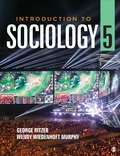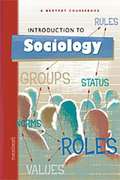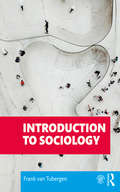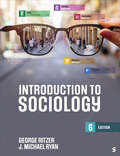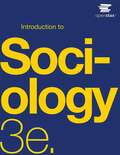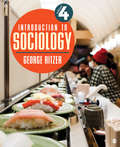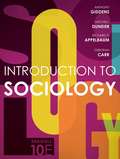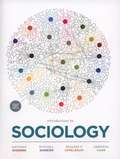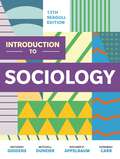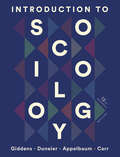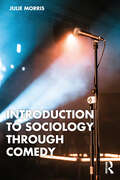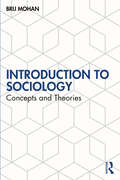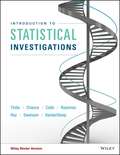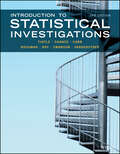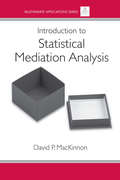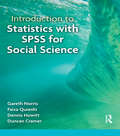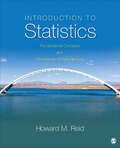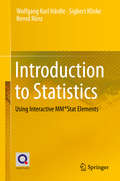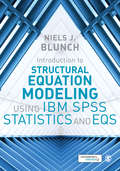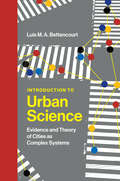- Table View
- List View
Introduction to Sociology
by Dr. George Ritzer Dr. Wendy Wiedenhoft MurphyIn the fully updated Fifth Edition of Introduction to Sociology, bestselling author George Ritzer shows you the relevance of sociology to your life. While providing a rock-solid foundation, the text illuminates traditional sociological concepts and theories, as well as some of the most compelling contemporary social phenomena: globalization, consumer culture, the Internet, and the “McDonaldization” of society. Packed with current examples and the latest research of how “public” sociologists are engaging with the critical issues of today, this new edition encourages you to apply a sociological perspective to your worldview—empowering you to participate in a global conversation about current social problems.
Introduction to Sociology
by Ethel Wood Judith Lloyd YeroSome of the topics covered in this book are: the world of sociology, culture, social structure & group behavior, socialization, deviance & crime, social stratification & class and race & ethnicity among others
Introduction to Sociology
by Frank van TubergenComprehensive and engaging, this textbook introduces students not only to foundational sociological work, but also to insights from contemporary sociological theory and research. This combined approach ensures that students become familiar with the core of sociology: key concepts, theories, perspectives, methods, and findings. Students will acquire the ability to think like a sociologist, investigate and understand complex social phenomena. This text presents a complete sociological toolkit, guiding students in the art of asking good sociological questions, devising a sophisticated theory and developing methodologies to observe social phenomena. The chapters of this book build cumulatively to equip students with the tools to quickly understand any new sociological topic or contemporary social problem. The textbook also applies the sociological toolkit to selected key sociological issues, showing how specific sociological topics can be easily investigated and understood using this approach. Taking a global and comparative perspective, the book covers a rich diversity of sociological topics and social problems, such as crime, immigration, race and ethnicity, media, education, family, organizations, gender, poverty, modernization and religion. The book presents a range of helpful pedagogical features throughout, such as: Chapter overview and learning goals summaries at the start of every chapter; Thinking like a sociologist boxes, encouraging students to reflect critically on learning points; Principle boxes, summarizing key sociological principles; Theory schema boxes, presenting sociological theories in a clear, understandable manner; Stylized facts highlighting key empirical findings and patterns; Key concepts and summary sections at the end of every chapter; and Companion website providing additional material for every chapter for both instructors and students, including PowerPoint lecture notes, discussion questions and answers, multiple-choice questions, further reading and a full glossary of terms. This clear and accessible text is essential reading for students taking introductory courses in sociology. It will also be useful for undergraduate and graduate courses in other social science disciplines, such as psychology, economics, human geography, demography, communication studies, education sciences, political science and criminology.
Introduction to Sociology
by George Ritzer J. Michael RyanIntroduction to Sociology offers a comprehensive guide that connects traditional sociological concepts and contemporary social phenomena, such as globalization, consumer culture, the internet, and "McDonaldization," to students′ lives in today′s global society. This accessible text encourages learners to apply a sociological perspective and explore how public sociologists address critical modern issues. This title is accompanied by a complete teaching and learning package. Contact your Sage representative to request a demo. Learning Platform / Courseware Sage Vantage is an intuitive learning platform that integrates quality Sage textbook content with assignable multimedia activities and auto-graded assessments to drive student engagement and ensure accountability. Unparalleled in its ease of use and built for dynamic teaching and learning, Vantage offers customizable LMS integration and best-in-class support. It’s a learning platform you, and your students, will actually love. Learn more. Assignable Video with Assessment Assignable video (available in Sage Vantage) is tied to learning objectives and curated exclusively for this text to bring concepts to life. Watch a sample video now. LMS Cartridge: Import this title’s instructor resources into your school’s learning management system (LMS) and save time. Don’t use an LMS? You can still access all of the same online resources for this title via the password-protected Instructor Resource Site. Learn more.
Introduction to Sociology
by George Ritzer J. Michael RyanIntroduction to Sociology offers a comprehensive guide that connects traditional sociological concepts and contemporary social phenomena, such as globalization, consumer culture, the internet, and "McDonaldization," to students′ lives in today′s global society. This accessible text encourages learners to apply a sociological perspective and explore how public sociologists address critical modern issues. This title is accompanied by a complete teaching and learning package. Contact your Sage representative to request a demo. Learning Platform / Courseware Sage Vantage is an intuitive learning platform that integrates quality Sage textbook content with assignable multimedia activities and auto-graded assessments to drive student engagement and ensure accountability. Unparalleled in its ease of use and built for dynamic teaching and learning, Vantage offers customizable LMS integration and best-in-class support. It’s a learning platform you, and your students, will actually love. Learn more. Assignable Video with Assessment Assignable video (available in Sage Vantage) is tied to learning objectives and curated exclusively for this text to bring concepts to life. Watch a sample video now. LMS Cartridge: Import this title’s instructor resources into your school’s learning management system (LMS) and save time. Don’t use an LMS? You can still access all of the same online resources for this title via the password-protected Instructor Resource Site. Learn more.
Introduction to Sociology
by OpenStaxIntroduction to Sociology 3e aligns to the topics and objectives of many introductory sociology courses. It is arranged in a manner that provides foundational sociological theories and contexts, then progresses through various aspects of human and societal interactions. The new edition is focused on driving meaningful and memorable learning experiences related to critical thinking about society and culture. The text includes comprehensive coverage of core concepts, discussions and data relevant to a diverse audience, and features that draw learners into the discipline in powerful and personal ways. Overall, Introduction to Sociology 3e aims to center the course and discipline as crucial elements for understanding relationships, society, and civic engagement; the authors seek to lay the foundation for students to apply what they learn throughout their lives and careers. The authors, reviewers, and the entire team worked to build understanding of the causes and impacts of discrimination and prejudice. Introduction to Sociology 3e contains dozens of examples of discrimination and its outcomes regarding social science, society, institutions, and individuals. The text seeks to strike a balance between confronting the damaging aspects of our culture and history and celebrating those who have driven change and overcome challenges. The core discussion of these topics are present in Chapter 11 on Race and Ethnicity, and Chapter 12 on Gender, Sex, and Sexuality, but their causes and effects are extensively discussed in the context of other topics, including education, law enforcement, government, healthcare, the economy, and so on. Together and when connected by an instructor, these elements have potential for deep and lasting effects. This is the official print version of this OpenStax textbook. <P><P>OpenStax makes full-color hardcover and B&W paperback print copies available for students who prefer a hardcopy textbook to go with the free digital version of this OpenStax title. The textbook content is exactly the same as the OpenStax digital book. This textbook is available for free download at the OpenStax dot org website, but as many students prefer to study with hardcopy books, we offer affordable OpenStax textbooks for sale through Amazon as well as most campus bookstores.
Introduction to Sociology (Fifth Edition)
by Laurence A. Bastirico Barbara G. Cashion J. Ross EshlemenIntroductory college textbook on sociology
Introduction to Sociology (Fourth Edition)
by George RitzerThis Fourth Edition of George Ritzer’s Introduction to Sociology shows students the relevance of sociology to their lives. While providing a rock-solid foundation, Ritzer illuminates traditional sociological concepts and theories, as well as some of the most compelling contemporary social phenomena: globalization, consumer culture, the digital world, and the “McDonaldization” of society. With examples on every page from current events and contemporary research to stories about “public” sociologists who are engaging with the critical issues of today, the text demonstrates the power of sociology to explain the world and address the diversity of questions that sociologists seek to answer.
Introduction to Sociology (Seagull 10th Edition)
by Anthony Giddens Richard P. Appelbaum Mitchell Duneier Deborah CarrIntroduction to Sociology focuses only on what students need to know in order to master the sociological concepts taught in the introductory course. Each chapter in the Tenth Edition follows the same consistent four-part structure: First, the authors introduce the basic concepts before discussing sociological theory. They then turn their attention to current research and finally wrap up by exploring unanswered questions that face sociologists today. This consistent, thoughtful organization―coupled with learning objectives, Concept Checks, and Big Picture concept maps―keeps students focused on the core concepts. Now supported by InQuizitive, the Tenth Edition builds on the book’s long-standing strengths: emphasis on linking micro and macro sociology, coverage of the best recent research, and an exceptionally affordable price relative to other comprehensive texts.
Introduction to Sociology (Seagull 8th Edition)
by Anthony Giddens Richard P. Appelbaum Mitchell Duneier Deborah CarrGiddens (London School of Economics, UK) et al. present a sociology textbook that combines classic theories of the field with empirically-grounded studies and examples from real life to show the basic issues of interest to today's sociologists. The text emphasizes eight themes: the link between micro and macro-level contexts; social change in the world; the globalization of social life; the importance of comparative study; a historical approach; issues of social class, gender, and race; sociological research methods; and the relationship between the social and the personal. Basic concepts are explained within chapters rather than at the beginning of the text. This edition has revised discussion of the sociological imagination and perspective; revised chapters on methods, gender, and aging; and an expanded section on Alzheimer's. Statistics have been updated throughout. Annotation ©2011 Book News, Inc. , Portland, OR (booknews. com)
Introduction to Sociology (Seagull Thirteenth Edition)
by Anthony Giddens Richard P. Appelbaum Mitchell Duneier Deborah CarrThe most trusted textbook in sociology. With more than a million copies sold and counting, Introduction to Sociology is valued for its reliable and authoritative coverage of sociological concepts, theory, and research. This comprehensive survey of the field gives students everything they need to internalize core concepts and develop their sociological imaginations. Our stellar author team helps students understand key sociological insights and apply them to the big social issues of our time. New online learning resources support understanding and deep, engaged reading.
Introduction to Sociology (Seagull Twelfth Edition)
by Anthony Giddens Richard P. Appelbaum Mitchell Duneier Deborah CarrEverything students need to understand and navigate our changing social world The Introduction to Sociology, Twelfth Seagull Edition, features thoroughly revised coverage of the local and global impacts of increasing inequality. It offers new in-text tools to help students understand and apply theory to pressing social issues. A respected author team, up-to-date data, and new research examples ensure students get a thoughtful and current introduction to the discipline. And with a new full-color design—at the same low price—it is more engaging than ever. This purchase offers access to the digital ebook only.
Introduction to Sociology First Semester FYBA New NEP Syllabus - SPPU
by Dr Jyoti Suhas Gagangras Dr Sudhir Ashruba YevleThe textbook Introduction to Sociology for first-year undergraduate students, aligned with the NEP 2024 syllabus, provides a foundational understanding of sociology as a discipline. It introduces key concepts such as the nature, scope, and significance of sociology, emphasizing the study of human interactions, social structures, and institutions. The book explores the sociological perspective, enabling students to analyze societal patterns and understand cultural diversity. It also examines the role of sociology in addressing social challenges, fostering critical thinking, and contributing to social change. With a focus on practical applications, the textbook highlights the importance of sociology in shaping policies, improving social cohesion, and promoting equity. Designed as a comprehensive resource for students and educators, it combines theoretical insights with real-world examples, making it an essential guide for academic studies and societal understanding.
Introduction to Sociology First Year P.U.C. - Karnataka Board
by Department of Pre-University EducationThe book "Introduction to Sociology" provides a comprehensive overview of sociology as a discipline, exploring the fundamental concepts, theories, and methods used in the study of society. It begins by defining sociology and its significance in understanding the complex nature of human interactions and social structures. The text delves into key topics such as culture, socialization, social institutions, and social stratification, illustrating how these elements shape individual and collective behavior. By examining various sociological perspectives, including functionalism, conflict theory, and symbolic interactionism, the book encourages critical thinking about societal issues and the forces that drive social change. Designed for first-year students, this text serves as an essential foundation for further study in sociology, offering a balanced blend of theoretical insights and practical examples to engage and inform readers.
Introduction to Sociology Through Comedy
by Julie MorrisQuestioning society and one’s place in it is a common theme in both comedy and sociology. Understanding and subverting hierarchies and norms, exploring deviance and taboos, and relating lived experience to broader questions all hold a crucial place for them both.Introduction to Sociology Through Comedy teaches foundational sociological concepts using comedy, first considering the history of sociology before employing examples from comedians – including standalone comedy bits, sketches, characters, and scenes – to illustrate a specific theory, concept, or social phenomenon. The profession of comedy is then used as a case study for the application of sociological concepts, such as impression management, social stratification, racial segregation, deviance, and stigma, allowing readers to gain familiarity with the concepts while simultaneously practicing their application.This book explains why we laugh by applying theories of humor, which will bolster students’ understanding of sociological principles by forcing them to question their own assumptions – helping them to put why they laugh into sociological terms.
Introduction to Sociology: Concepts and Theories
by Brij MohanThis textbook explores the emergence of sociology as a distinct social science. Focusing on the evolution of social theories, movements and ideas through history, it analyses the dynamic relationship between the individual and the larger social forces around them. This volume examines the definitive aspects of societies, communities and social groups, and their intersections with culture, political and economic movements and religious institutions. It establishes the connections between sociology and other disciplines such as philosophy, history, political science, economics, psychology and anthropology to explore the interdependence between different realms of social life. The chapters in this book explain and highlight the significance of quantitative and qualitative methods of research in understanding the dynamics of social life. Drawing from the works of classical social theorists such as Auguste Comte, Herbert Spencer, Karl Marx, Emile Durkheim and Max Weber, this book traces the development of sociological perspectives and theories and their relevance in the history of ideas. Lucid and comprehensive, this textbook will be useful for undergraduate and postgraduate students of sociology, development studies, history of ideas, sociological thought, social theory, research methods, political science and anthropology.
Introduction to Space Syntax in Urban Studies
by Claudia Yamu Akkelies van NesThis open access textbook is a comprehensive introduction to space syntax method and theory for graduate students and researchers. It provides a step-by-step approach for its application in urban planning and design. This textbook aims to increase the accessibility of the space syntax method for the first time to all graduate students and researchers who are dealing with the built environment, such as those in the field of architecture, urban design and planning, urban sociology, urban geography, archaeology, road engineering, and environmental psychology. Taking a didactical approach, the authors have structured each chapter to explain key concepts and show practical examples followed by underlying theory and provided exercises to facilitate learning in each chapter. The textbook gradually eases the reader into the fundamental concepts and leads them towards complex theories and applications. In summary, the general competencies gain after reading this book are:– to understand, explain, and discuss space syntax as a method and theory;– be capable of undertaking various space syntax analyses such as axial analysis, segment analysis, point depth analysis, or visibility analysis;– be able to apply space syntax for urban research and design practice;– be able to interpret and evaluate space syntax analysis results and embed these in a wider context;– be capable of producing new original work using space syntax.This holistic textbook functions as compulsory literature for spatial analysis courses where space syntax is part of the methods taught. Likewise, this space syntax book is useful for graduate students and researchers who want to do self-study. Furthermore, the book provides readers with the fundamental knowledge to understand and critically reflect on existing literature using space syntax.
Introduction to Statistical Investigations
by George W. Cobb Allan J. Rossman Beth L. Chance Soma Roy Nathan L. Tintle Todd M. Swanson Jill L. VanderStoepThis book leads students to learn about the process of conducting statistical investigations from data collection, to exploring data, to statistical inference, to drawing appropriate conclusions. The authors focus on genuine research studies, active learning, and effective use of technology. In particular, they use simulation and randomization tests to introduce students to statistical inference, yielding a strong conceptual foundation that bridges students to theory-based inference approaches, which are presented throughout the book. This approach allows students to see the logic and scope of inference in the first chapter and to cycle through these ideas. The implementation follows the GAISE recommendations endorsed by the American Statistical Association.
Introduction to Statistical Investigations
by George W. Cobb Allan J. Rossman Beth L. Chance Soma Roy Nathan L. Tintle Todd M. Swanson Jill L. VanderstoepIntroduction to Statistical Investigations, Second Edition provides a unified framework for explaining variation across study designs and variable types, helping students increase their statistical literacy and appreciate the indispensable role of statistics in scientific research. Requiring only basic algebra as a prerequisite, the program uses the immersive, simulation-based inference approach for which the author team is known. Students engage with various aspects of data collection and analysis using real data and clear explanations designed to strengthen multivariable understanding and reinforce concepts. <P><P>Each chapter follows a coherent six-step statistical exploration and investigation method (ask a research question, design a study, explore the data, draw inferences, formulate conclusions, and look back and ahead) enabling students to assess a variety of concepts in a single assignment. Challenging questions based on research articles strengthen critical reading skills, fully worked examples demonstrate essential concepts and methods, and engaging visualizations illustrate key themes of explained variation. The end-of-chapter investigations expose students to various applications of statistics in the real world using real data from popular culture and published research studies in variety of disciplines. Accompanying examples throughout the text, user-friendly applets enable students to conduct the simulations and analyses covered in the book.
Introduction to Statistical Mediation Analysis (Multivariate Applications Ser.)
by David MacKinnonThis volume introduces the statistical, methodological, and conceptual aspects of mediation analysis. Applications from health, social, and developmental psychology, sociology, communication, exercise science, and epidemiology are emphasized throughout. Single-mediator, multilevel, and longitudinal models are reviewed. The author's goal is to help the reader apply mediation analysis to their own data and understand its limitations. Each chapter features an overview, numerous worked examples, a summary, and exercises (with answers to the odd numbered questions). The accompanying CD contains outputs described in the book from SAS, SPSS, LISREL, EQS, MPLUS, and CALIS, and a program to simulate the model. The notation used is consistent with existing literature on mediation in psychology. The book opens with a review of the types of research questions the mediation model addresses. Part II describes the estimation of mediation effects including assumptions, statistical tests, and the construction of confidence limits. Advanced models including mediation in path analysis, longitudinal models, multilevel data, categorical variables, and mediation in the context of moderation are then described. The book closes with a discussion of the limits of mediation analysis, additional approaches to identifying mediating variables, and future directions. Introduction to Statistical Mediation Analysis is intended for researchers and advanced students in health, social, clinical, and developmental psychology as well as communication, public health, nursing, epidemiology, and sociology. Some exposure to a graduate level research methods or statistics course is assumed. The overview of mediation analysis and the guidelines for conducting a mediation analysis will be appreciated by all readers.
Introduction to Statistics with SPSS for Social Science
by Dennis Howitt Duncan Cramer Gareth Norris Faiza QureshiThis is a complete guide to statistics and SPSS for social science students. Statistics with SPSS for Social Science provides a step-by-step explanation of all the important statistical concepts, tests and procedures. It is also a guide to getting started with SPSS, and includes screenshots to illustrate explanations. With examples specific to social sciences, this text is essential for any student in this area.
Introduction to Statistics: Fundamental Concepts and Procedures of Data Analysis
by Howard M. ReidUsing a truly accessible and reader-friendly approach, this comprehensive introduction to statistics redefines the way statistics can be taught and learned. Unlike other books that merely focus on procedures, Reid’s approach balances development of critical thinking skills with application of those skills to contemporary statistical analysis. He goes beyond simply presenting techniques by focusing on the key concepts readers need to master in order to ensure their long-term success. Indeed, this exciting new book offers the perfect foundation upon which readers can build as their studies and careers progress to more advanced forms of statistics. Keeping computational challenges to a minimum, Reid shows readers not only how to conduct a variety of commonly used statistical procedures, but also when each procedure should be utilized and how they are related. Following a review of descriptive statistics, he begins his discussion of inferential statistics with a two-chapter examination of the Chi Square test to introduce students to hypothesis testing, the importance of determining effect size, and the need for post hoc tests. When more complex procedures related to interval/ratio data are covered, students already have a solid understanding of the foundational concepts involved. Exploring challenging topics in an engaging and easy-to-follow manner, Reid builds concepts logically and supports learning through robust pedagogical tools, the use of SPSS, numerous examples, historical quotations, insightful questions, and helpful progress checks.
Introduction to Statistics: Using Interactive MM*Stat Elements
by Wolfgang Karl Härdle Sigbert Klinke Bernd RönzThis book covers all the topics found in introductory descriptive statistics courses, including simple linear regression and time series analysis, the fundamentals of inferential statistics (probability theory, random sampling and estimation theory), and inferential statistics itself (confidence intervals, testing).Each chapter starts with the necessary theoretical background, which is followed by a variety of examples. The core examples are based on the content of the respective chapter, while the advanced examples, designed to deepen students’ knowledge, also draw on information and material from previous chapters.The enhanced online version helps students grasp the complexity and the practical relevance of statistical analysis through interactive examples and is suitable for undergraduate and graduate students taking their first statistics courses, as well as for undergraduate students in non-mathematical fields, e.g. economics, the social sciences etc.
Introduction to Structural Equation Modeling Using IBM SPSS Statistics and EQS
by Niels J. BlunchThis student orientated guide to structural equation modeling promotes theoretical understanding and inspires students with the confidence to successfully apply SEM. Assuming no previous experience, and a minimum of mathematical knowledge, this is an invaluable companion for students taking introductory SEM courses in any discipline. Niels Blunch shines a light on each step of the structural equation modeling process, providing a detailed introduction to SPSS and EQS with a focus on EQS' excellent graphical interface. He also sets out best practice for data entry and programming, and uses real life data to show how SEM is applied in research. The book includes: Learning objectives, key concepts and questions for further discussion in each chapter. Helpful diagrams and screenshots to expand on concepts covered in the texts. A wide variety of examples from multiple disciplines and real world contexts. Exercises for each chapter on an accompanying companion website. A detailed glossary. Clear, engaging and built around key software, this is an ideal introduction for anyone new to SEM. Available with Perusall—an eBook that makes it easier to prepare for class Perusall is an award-winning eBook platform featuring social annotation tools that allow students and instructors to collaboratively mark up and discuss their SAGE textbook. Backed by research and supported by technological innovations developed at Harvard University, this process of learning through collaborative annotation keeps your students engaged and makes teaching easier and more effective. Learn more.
Introduction to Urban Science: Evidence and Theory of Cities as Complex Systems
by Luis M. BettencourtA novel, integrative approach to cities as complex adaptive systems, applicable to issues ranging from innovation to economic prosperity to settlement patterns.Human beings around the world increasingly live in urban environments. In Introduction to Urban Science, Luis Bettencourt takes a novel, integrative approach to understanding cities as complex adaptive systems, claiming that they require us to frame the field of urban science in a way that goes beyond existing theory in such traditional disciplines as sociology, geography, and economics. He explores the processes facilitated by and, in many cases, unleashed for the first time by urban life through the lenses of social heterogeneity, complex networks, scaling, circular causality, and information.Though the idea that cities are complex adaptive systems has become mainstream, until now those who study cities have lacked a comprehensive theoretical framework for understanding cities and urbanization, for generating useful and falsifiable predictions, and for constructing a solid body of empirical evidence so that the discipline of urban science can continue to develop. Bettencourt applies his framework to such issues as innovation and development across scales, human reasoning and strategic decision-making, patterns of settlement and mobility and their influence on socioeconomic life and resource use, inequality and inequity, biodiversity, and the challenges of sustainable development in both high- and low-income nations. It is crucial, says Bettencourt, to realize that cities are not "zero-sum games" and that knowledge, human cooperation, and collective action can build a better future.
